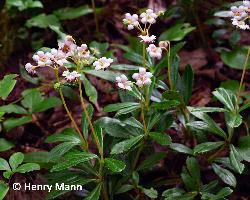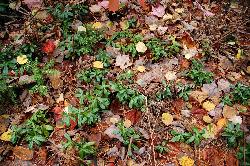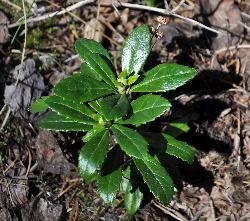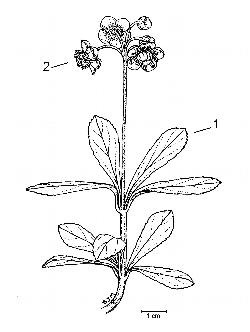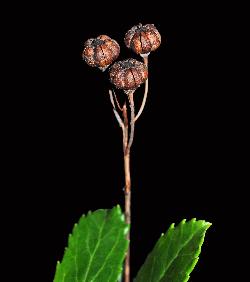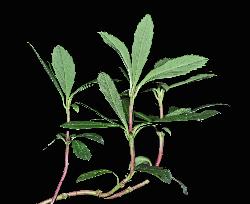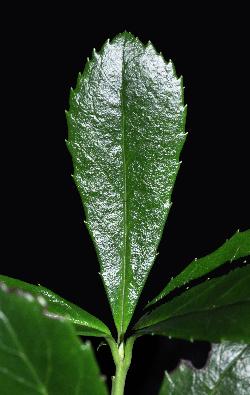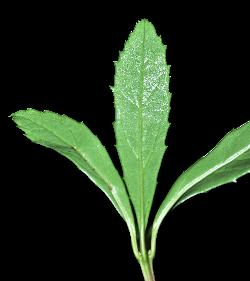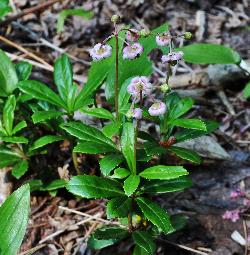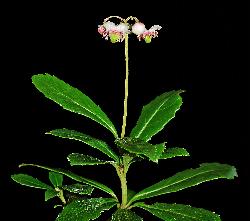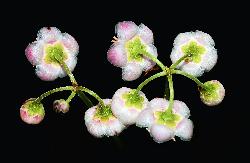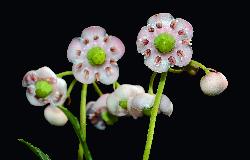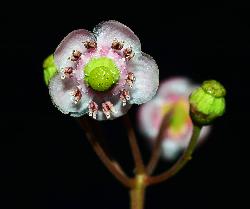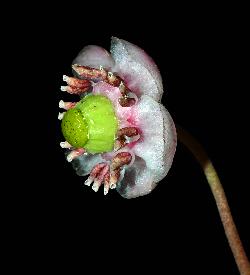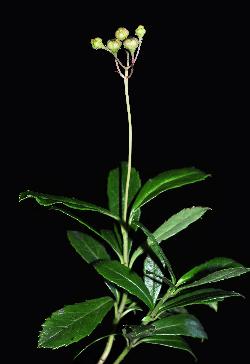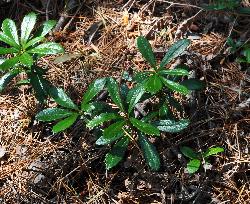Fr: chimaphile à ombelles, herbe à peigne, herbe à clef
Ericaceae - Heath Family
Note: Numbers given in square brackets in the text refer to the images presented above; image numbers are displayed to the lower left of each image.
General: An evergreen perennial forb, with erect shoots, to 3 dm tall [1–3]. Pipsissewa is a rare shade-tolerant understorey species in insular Newfoundland, but absent from Labrador. It reproduces by seed or vegetatively, with horizontal rhizomes producing erect shoots with whorled leaves. Pipsissewa and similar perennial forbs are sometimes classified as subshrubs, but they lack woody above-ground stems with overwintering buds, a key trait of shrubs. In Canada, this species is represented by subsp. umbellata. Previously, Newfoundland plants had been classified as subsp. cisatlantica (S.F. Blake) Hultén, which was described as having an eastern North American range (Blake 1917), but this variety has since been included in the broader subsp. umbellata, with a range that includes much of North America and Eurasia (Dorr 1995).
Key Features: (numbers 1–2 refer to the illustration [4])
- Mature plants have 2–3 whorls of dark green, lustrous, oblanceolate leaves, with 3–5 leaves in each whorl.
- The inflorescence is an umbellate raceme; flowers have 5 pink to white, orbicular, waxy petals, 10 stamens, and a single superior ovary with a large, circular, lens-shaped (lenticular) stigma.
- The fruit is an erect brown globose capsule, broader than tall, depressed at the centre around the persistent stigma [5].
Stems: Simple, erect, perennial, and slender, 3–26 cm tall, often with 1–2 erect branches from lower nodes. The slightly woody rhizomes are creeping and give rise to perennial vegetative and flowering shoots [6].
Leaves: Simple, evergreen, whorled, pinnately-veined, glabrous, and short-petiolate. Leaves occur in 1–3 loose whorls of 3–5 leaves, each whorl separated by a distinct internode. Leaf blades are coriaceous, oblanceolate to obovate, and 3–7 cm long by 1–2.2 cm wide; blades are dark green and lustrous above [7–8], noticeably veined and paler beneath [9]. The base tapers gradually to the 5–12 mm long petiole, the apex is blunt (obtuse) to pointed (acute) and slightly mucronate at the tip, margins are serrate with short sharp teeth.
Flowers: Bisexual; usually with 2–8 flowers borne in a terminal umbellate raceme that elongates with maturity [10–12]; occasionally a single flower (or fruit) subtended by a leaf occurs on the flowering stalk (peduncle) below the main inflorescence [1, left plant]. The peduncle is erect, straight, 4–10 cm long, and puberulent; pedicels are recurved to nodding, 17–35 cm long (Freeman 2009), and a single narrow bract occurs at about the middle of each pedicel. Flower buds are spherical with overlapping (imbricate) petals [13]. The calyx has 5 spreading, broadly ovate, green lobes [14]; the 5 pink-tinged to white petals are orbicular, 4–12 mm long by 4–8 mm wide, with erose margins at maturity [15]. Flowers have regular symmetry (actinomorphic) and are initially bowl-shaped, with the concave down-curved petals arching over the stamens [16–17]. Flowering occurs during a 2-week period in mid-summer, although individual flowers have only a 4-day flowering period. As flower buds open, the petals bend backward (reflex), exposing the stamens and large ovary. The 10 stamens are 5–7 mm long; filaments are often bright pink at the broader, 1–1.5 mm wide base; the two small basal lobes of the filaments have ciliate margins [18-19]. Anthers are pink to pinkish-brown and 2–3 mm long; the 2 locules (theca) of the anthers terminate in short 1 mm long tubes that end in a relatively large pore through which pollen is shed [20]. Initially, the filaments are curved inward, with the anther tubes pointing towards the flower base; during flowering, the filaments arch outward, rotating the anthers about 180 degrees, resulting in the tubes pointing downward [21] (Standley et al. 1988).
The large superior ovary is light green, broadly conical, somewhat 5-angled, and composed of 5 carpels. At the top of the ovary is a large sticky lenticular stigma, 2.4–4 mm across [22]; the style appears absent, but is short, 0.1–0.8 mm long, and situated in the depressed top of the ovary (Fernald 1970, Freeman 2009). Flowers are self-compatible (weakly autogamous), but cross pollination increases seed set (Barrett and Helenurm 1987). Pollination is by insects (entomophily), primarily bumblebees (Bombus spp.); contrary to some reports, Standley et al. (1988) indicate that bees do not buzz (sonicate) Chimaphila flowers to release pollen, but receive and transfer pollen as they feed on nectar at the base of the ovary. Freeloader bees (Paramyia nitens (Loew)) and pollen-eating staphylinid beetles also visit the flowers, but play a small role in pollination (Barrett and Helenurm 1987).
Fruit: An erect depressed-globose capsule, 6–10 mm long by 4–6 mm wide [5, 23–24]. Mature fruits developed on just over 45% of flowers (Helenurm and Barrett 1987); dehiscence of the capsules occurs from the apex down (basipetally). Seeds are numerous and very small; dispersal is by wind (anemochory).
Ecology and Habitat: Pipsissewa is a forest species rarely encountered in insular Newfoundland and absent from Labrador. Damman (1965) described it within a group of species with southern affinities, including red pine (Pinus resinosa Aiton), Houghton’s sedge (Carex houghtoniana Torr. ex Dewey), and eastern teaberry or wintergreen (Gaultheria procumbens L.), which occur in widely separated stations that were probably more widespread during the post glacial hypsithermal period. It appears to grow best in deep shade probably because of its obligate association with mycorrhizal fungi, although poorly growing individuals have been observed on open areas (Mann and Butt 1997). Elsewhere in Canada, it is considered to be a good indicator of dry nutrient-poor site conditions, usually sandy or rocky pine and spruce forests (Ringius and Simms 1998).
Edaphic Grid: See image [25]: the Edaphic Grid for Chimaphila umbellata.
Forest Types: Pipsissewa is only recorded in the forest classification in one plot from near Flat Bay Brook in Western Newfoundland:
- Betuletum typicum (White Birch-Mountain Alder Forest Association)
Based on the observations of Mann and Butt (1997) and limited observations of the Indian Pond populations, it appears that pipsissewa could occupy most of the balsam fir forest types on dry to moist, medium-nutrient sites. Within the Appalachian Hills Ecoregion of the south shore of Québec it occurs with highest frequency (76–100%) on mesic, medium-nutrient sites but can also occur with moderate frequency (11–25%) in very rich mesic sites (Blouin and Berger 2002).
Succession: Pipsissewa across its range appears to occur in all stages of stand development suggesting a wide range of light tolerance (Matthews 1994). Observations in Newfoundland by Mann and Butt (1997) suggest that plants in deep shade of dense second growth appeared healthier than those in the open. Pipsissewa can reproduce through the production of seed, but vegetative reproduction through the spread of below-ground rhizomes appears to be the immediate response to disturbance by fire and cutting. Pipsissewa, because of its shallow rhizome system, is limited to the organic layer, can only survive moderate severity fires, and after intense fire must re-colonize burnt sites through seed dispersal from surviving populations (Matthews 1994).
Distribution: Chimaphila umbellata is a circumboreal species that is rare in Newfoundland (ranked an S2) and absent from Labrador; it occurs in all Provinces of Canada except Nunavut. Historically, pipsissewa was known from only 3 locations in north-central Newfoundland (Bouchard et al. 1991, Rouleau and Lamoureux 1992). Subsequent searches by local botanists have discovered several new sites, including one population north of Indian Pond on the Northern Peninsula (Boland 1994) and several populations in the Pasadena-Deer Lake area of western Newfoundland (Mann and Butt 1997), as well as northeastern Newfoundland. In the United States, it extends from Maine southwest to North Carolina and west to Minnesota; it is absent from the Midwest, but occurs again sporadically in the western States (USDA, NRCS, 2016).
Similar Species: Pipsissewa has very distinct flowers that are easily recognizable and no other forest species has whorls of oblanceolate leaves. However, the capsules may be mistaken for those of pyrola (Pyrola), species, which have basal rosettes of petiolate leaves with oblong or rounded leaf blades.


